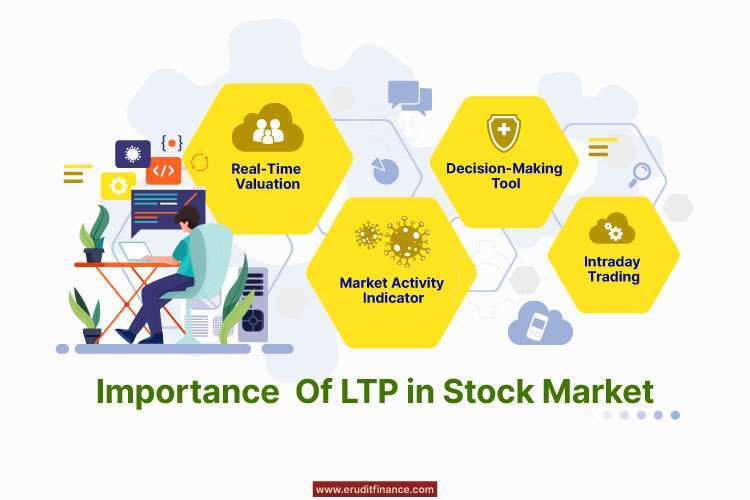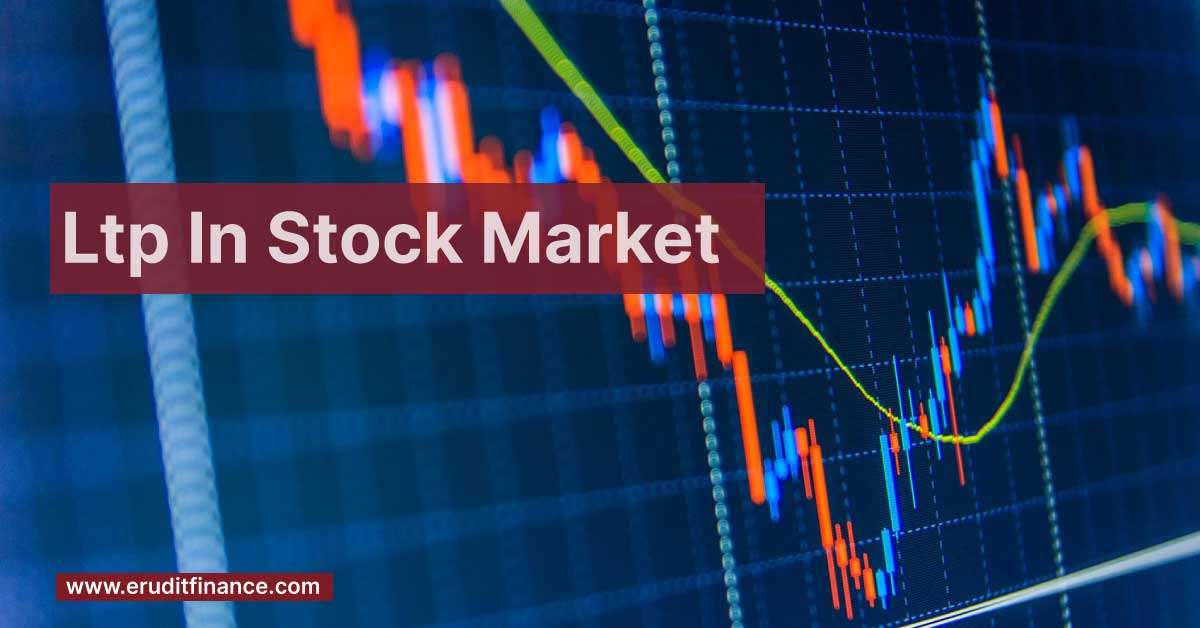In the stock market, “LTP” stands for “Last Traded Price.” It represents the latest price at which a specific security, such as a stock, was bought or sold. The Last Traded Price is a crucial metric for investors and traders, providing real-time information about the most recent market activity for a particular stock. This dynamic indicator reflects the immediate valuation of a security based on the latest transactions. Traders often use LTP to gauge current market sentiment and make informed decisions regarding buying or selling securities, as it offers a snapshot of the stock’s value at the most recent point in time.
Ltp in Stock Market
In the realm of the stock market, “LTP” is an acronym denoting the “Last Traded Price,” a key metric that encapsulates the most recent transaction price for a specific security, notably stocks. Here’s a breakdown of its significance using pointers.

1). Real-Time Valuation- LTP provides investors with an instantaneous snapshot of a stock’s value by representing the price at which the last trade occurred. This up-to-the-minute information is crucial for market participants seeking the latest market dynamics.
2). Market Activity Indicator- LTP serves as a dynamic indicator of current market activity. Investors often analyze this metric to discern prevailing trends and sentiments surrounding a particular stock, helping them make timely and informed decisions.
3). Transaction Benchmark- As the most recent transaction price, LTP acts as a benchmark for evaluating the fair market value of a security. This aids traders in determining whether a stock is currently overvalued or undervalued based on recent market dynamics.
4). Decision-Making Tool- Traders frequently utilize LTP to inform their trading strategies. The metric’s real-time nature allows traders to adapt quickly to changing market conditions, influencing decisions related to buying, selling, or holding positions.
5). Widely Accessible Information- LTP is readily available on financial news platforms, stock market quotes, and trading interfaces. Its accessibility enables market participants to stay abreast of the latest developments and price movements in their portfolios.
In summary, the Last Traded Price is a pivotal metric in the stock market, providing a timely and relevant assessment of a security’s value.
How Do You Calculate LTP Value?
The Last Traded Price (LTP) is not calculated; rather, it is a direct representation of the price at which the most recent trade of a particular security, such as a stock, occurred in the market. The LTP is determined by the latest transaction between a buyer and a seller. Here’s a simplified explanation of how it works.
| Market Transaction | Continuous Updates | Market Data Feeds | Widely Available |
Market Transaction– The Last Traded Price is established through a transaction between a buyer and a seller in the market. When a trade is executed, the price at which the transaction takes place becomes the new Last Traded Price.
Continuous Updates- As trades happen in real-time, the Last Traded Price is continuously updated to reflect the most recent transaction. This provides market participants with the latest information about the value of a security.
Market Data Feeds- Financial exchanges and trading platforms disseminate real-time market data, including the Last Traded Price, through data feeds. Investors and traders can access this information to stay informed about the current market dynamics.
Widely Available- The Last Traded Price is widely available on various financial platforms, stock market quotes, and trading interfaces. It serves as a key indicator for investors and traders to assess the immediate market value of a security.
Is LTP and Market Price Same?
Yes, the Last Traded Price (LTP) and the market price are essentially the same in the context of financial markets, particularly in the stock market. The Last Traded Price refers to the most recent price at which a specific security, such as a stock, was bought or sold in the market. Similarly, the market price is the current prevailing price at which a security can be bought or sold in the market.
| Last Traded Price (LTP) | Market Price |
| This is the specific price at which the most recent trade of security occurred. It represents the latest transaction price | This term is often used interchangeably with the Last Traded Price. It generally refers to the current price at which a security is trading in the market, and in many cases, it is synonymous with the LTP. |
Is LTP and Closing Price Same?
No, the Last Traded Price (LTP) and the Closing Price are different concepts in the context of financial markets, particularly in the stock market.
| Last Traded Price (LTP) | Closing Price |
| This is the most recent price at which a specific security, such as a stock, was bought or sold in the market. The LTP is a real-time indicator that represents the latest transaction price. | This is the final price at which a security trades on a particular trading day. It is the last price recorded before the market closes. The closing price is significant because it is used to calculate various financial metrics, and it often serves as a reference point for analyzing a stock’s performance over time. |
Is LTP and Premium Same?
No, the Last Traded Price (LTP) and Premium are different concepts in the context of financial markets.
| Last Traded Price (LTP) | Premium |
| This represents the most recent price at which a specific security, such as a stock, was bought or sold in the market. The LTP is a real-time indicator that reflects the latest transaction price. | The term “premium” is often used in various contexts. In the context of options or bonds, a premium typically refers to an additional amount paid above the face value or the intrinsic value of the security. For example, the premium on an options contract is the price paid for the right to buy or sell the underlying asset at a specified strike price. |
Why is LTP Important in Stock Market?
The Last Traded Price (LTP) is important in the stock market for several reasons:
- Real-Time Valuation- LTP provides investors with the most recent valuation of a stock by representing the price at which the last trade occurred. It offers real-time insight into the market’s perception of a stock’s value.
- Market Activity Indicator- LTP serves as a dynamic indicator of current market activity. It reflects the most recent transaction, helping investors gauge the immediate sentiment and demand for a particular stock.
- Decision-Making Tool- Traders use LTP as a critical factor in decision-making. By analyzing the last traded price, investors can make informed decisions regarding buying, selling, or holding positions based on the most recent market activity.

- Price Discovery- LTP plays a role in price discovery, helping establish the fair market value of a stock at a given point in time. It reflects the equilibrium between buyers and sellers in the market.
- Intraday Trading- For intraday traders who engage in short-term trades within a single trading day, LTP is particularly crucial. It provides the latest information for making quick decisions in rapidly changing market conditions.
- Technical Analysis- Technical analysts often use LTP data to construct charts and analyze price trends. Understanding the last traded price is fundamental to various technical indicators and chart patterns.
- Benchmark for Orders- Investors and traders may set limit orders based on the last traded price. For example, a trader might place a buy order with a limit price slightly below the LTP, anticipating a favorable entry point.
- Market Transparency- LTP contributes to market transparency by providing up-to-date information about a stock’s value. This transparency is essential for maintaining fair and efficient financial markets.
In summary, the Last Traded Price is a crucial element in stock market dynamics, offering real-time information that aids investors and traders in making timely and informed decisions. It serves as a key indicator of a stock’s current market value and helps participants navigate the ever-changing landscape of financial markets.
Bottomline:-
The Last Traded Price (LTP) in the stock market is the most recent transaction value of a security, representing real-time market sentiment and valuation. It serves as a crucial tool for investors and traders, offering insights into immediate market activity. The LTP is fundamental for decision-making, price discovery, and intraday trading, providing transparency and serving as a benchmark for orders. In essence, LTP is pivotal in navigating dynamic market conditions and making informed financial choices.
Also Read:-










